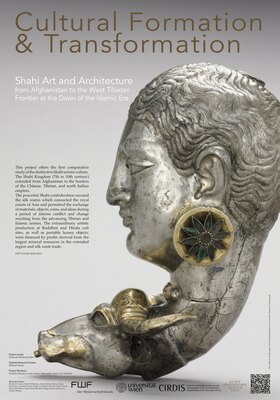
The goal of the project "Cultural Formation and Transformation: Shahi Buddhist Art and Architecture from Afghanistan to the West Tibetan Frontier at the Dawn of the Islamic Era" is to define a narrative cultural history of the Shahi kingdom (7th to 10th century). Due to its extensive temporal and geographic parameters—extending from Afghanistan to the borders of Tibetan empire — the kingdom played a pivotal role in the history of Inner and South Asia. Despite its importance for the history of later Buddhist art and the formation of Islamic art, the cultural history of this almost 300-year period has never been the focus of dedicated research. We aim to clarify the corpus of Shahi material culture and its transmission by comparing known portable objects, principally sculptures and coins, with available visual material from extant cultic sites.
The Shahi kingdom is marked by crucial transformations—the advent of Islam, expansion of Hindu cults in Afghanistan and Pakistan, and beginnings of the Buddhist Tantric tradition. As the first study of Buddhist and Hindu religious arts within the context of the expanding Islamic culture, this project will make significant contributions to understanding the history of Islamic, Buddhist, and Hindu art. Our focus on the mobility of religious objects and iconographies clarifies the convergence of aspects of different cult practices, as well as the evolution of later Mahayana ideas that accompanied the transfer of Buddhist visual culture to Tibet. Additional questions: how do changes in Shahi visual culture reflect the increasing presence of Islamic, Chinese, and Tibetan forces on the kingdom’s borders; what is the impact of Shahi visual culture on the earliest Indo-Tibetan temple plans and visual programs founded during this period; and particularly how can we define Tantric cults and iconographies across the kingdom?
Fieldwork in India and Pakistan and collection research at museums housing significant Shahi artworks will provide the primary data that enable us to expand the research tools housed at CIRDIS/University of Vienna (WHAV/HAV; BibDB; Numismatic Database) in order to create a Shahi Kingdom Database. The primary data will be studied using methods of mapping and network analysis. A diachronic analysis of the mobility and transmission of objects across the geographic and temporal extent of the kingdom will result in a narrative cultural history for the Shahi period. The convergent patterns formed by mapping selected material artifacts will permit the empirical study of political, economic, and social networks. These networks reveal the mobility of materials, objects, and ideas, that in turn allows us to understand possible patterns of production, consumption, distribution and diffusion.
FWF Project P-31246 (2018-2021)
Project Leader
Deborah Klimburg-Salter
National Research Partner
Michael Alram (Kunsthistorisches Museum Wien)
Project Members
Aleksandra Apic
Natasha Kimmet
Malgorzata Lenko